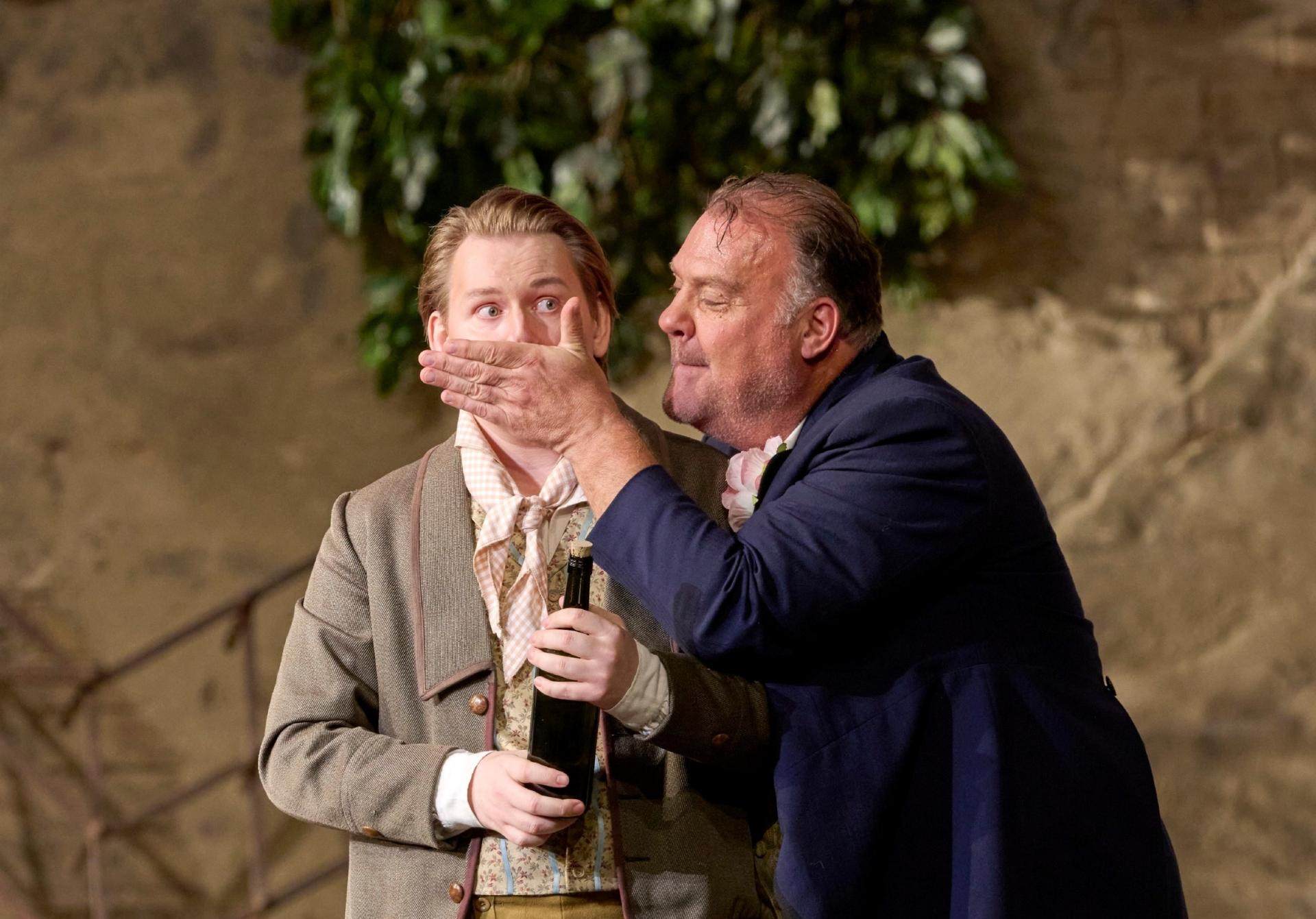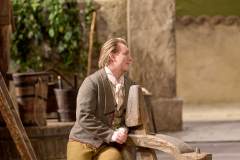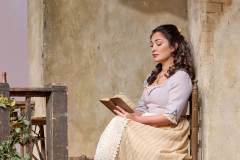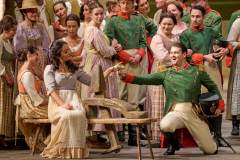The Elixir of Love
Mo | Tu | We | Th | Fr | Sa | Su |
Synopsis
ACT 1
The young tenant farmer Adina, young, rich and well-read, is idolized by the penniless and insecure Nemorino.
During a break in her work, she recites the story of Tristan and Isolde and the wonderful love potion to the villagers, not without irony. Sergeant Belcore moves in and takes up quarters with his soldiers. He immediately courts Adina and confidently demands her love. But she evades him and asks for patience.
When Nemorino courts her, she rejects him: love is just a game for her and she wants to remain unattached from now on. The quack doctor Dulcamara arrives and praises his skills to the people. Nemorino takes heart and asks the miracle doctor for the famous love potion. Dulcamara sees through the situation and sells the coveted elixir - in reality a bottle of wine - to the grateful Nemorino for all his cash. Not without pointing out to Nemorino that the supposed potion only works after 24 hours (i.e. after Dulcamara has already left the village).
Nemorino immediately tastes the drug - and his mood improves. He becomes more confident with Adina and pretends that he is no longer interested in her. Now she can woo him. This sudden change of heart is not to Adina's liking either. She wants to find out whether Nemorino's feelings have really grown cold and declares without further ado that she wants to marry Belcore on the spot. Nemorino is completely flabbergasted. This is not how he imagined the love potion would work.
ACT 2
The wedding is being prepared, but Adina delays the conclusion of the marriage contract.
In desperation, Nemorino asks Dulcamara for a second bottle of the miracle elixir. As he has no more money, Belcore recruits him as a soldier and procures another bottle for the hand money he receives. The supposed love potion works unexpectedly quickly:
Nemorino is flattered by a whole host of girls. However, he does not suspect the true background to their affection: Giannetta has spread the hitherto secret news that Nemorino's wealthy uncle has died and named him as his sole heir. Nemorino finds the girls' company extremely pleasant and pretends to ignore Adina, which arouses her jealousy. She finally finds out from Dulcamara why Nemorino has allowed himself to be recruited.
When the quack offers her the love potion, she refuses: she knows a more effective way to win over Nemorino, to whom she is devoted after all: her eyes. She pays Belcore back the hand money, uses it to buy Nemorino's freedom and confesses her love for him. Her happiness in love is accompanied by financial happiness: Nemorino and Adina find out about the inheritance. Finally, Dulcamara takes advantage of the situation: he boasts about his art, thanks to which Nemorino has achieved both his happiness in love and his fortune.
ACT 1 - 70 MIN
INTERMISSION - 25 MIN
ACT 2 - 50 MIN
Program and cast
Season 23/24
Adina: Florina Ilie
Nemorino: Xabier Anduaga
Belcore: Clemens Unterreiner
Doctor Dulcamara: Alex Esposito
Giannetta: Daria Kolisan
Servant of Dulcamara: Herbert Michael Burggasser
Musical direction: Francesco Ivan Ciampa
Direction: Otto Schenk
Stage and costumes: Jürgen Rose
Season 24/25
Adina: Nadine Sierra
Nemorino: Xabier Anduaga
Belcore: Davide Luciano
Doctor Dulcamara: Bryn Terfel
Musical direction: Francesco Ivan Ciampa
Direction: Otto Schenk
Stage and costumes: Jürgen Rose
Vienna State Opera
Public Transport
Subway lines: U1, U2, U4
Trams: 1, 2, D, J, 62, 65
Buses: 59A
Local Railway: Badner Bahn
Stops: Karlsplatz / Opera
Taxi stands are available nearby.
Parking
Parking is only € 6, - for eight hours!
The Wiener Staatsoper and the ÖPARK Kärntner Ring Garage on Mahlerstraße 8, under the “Ringstraßengalerien”, offer the patrons of the Vienna State Opera a new, reduced parking fee. You can park in the Kärntner Ring Garage for up to 8 hours and pay only a flat fee of € 6, -. Just validate your ticket at one of the discount machines inside the Wiener Staatsoper. The normal rate will be charged for parking time greater than 8 hours. The validation machines can be found at the following coat checks: Operngasse, Herbert von Karajan-Platz, and the right and left and balcony galleries.
Important: In order to get the discount, please draw a ticket and do not use your credit card when entering the garage!
After devaluing your ticket in the Wiener Staatsoper you can pay comfortably by credit card or cash at the vending machines.
The machines accept coins and bills up to 50.- Euro. Parking time longer than 8 hours will be charged at the normal rate.
History
The structure of the opera house was planned by the Viennese architect August Sicard von Sicardsburg, while the inside was designed by interior decorator Eduard van der Nüll. It was also impacted by other major artists such as Moritz von Schwind, who painted the frescoes in the foyer, and the famous "Zauberflöten" (“Magic Flute”) series of frescoes on the veranda. Neither of the architects survived to see the opening of ‘their’ opera house: the sensitive van der Nüll committed suicide, and his friend Sicardsburg died of a stroke soon afterwards.
On May 25, 1869, the opera house solemnly opened with Mozart's Don Giovanni in the presence of Emperor Franz Joseph and Empress Elisabeth.
The popularity of the building grew under the artistic influence of the first directors: Franz von Dingelstedt, Johann Herbeck, Franz Jauner, and Wilhelm Jahn. The Vienna opera experienced its first high point under the direction of Gustav Mahler. He completely transformed the outdated performance system, increased the precision and timing of the performances, and also utilized the experience of other noteworthy artists, such as Alfred Roller, for the formation of new stage aesthetics.
The years 1938 to 1945 were a dark chapter in the history of the opera house. Under the Nazis, many members of the house were driven out, pursued, and killed, and many works were not allowed to be played.
On March 12, 1945, the opera house was devastated during a bombing, but on May 1, 1945, the “State Opera in the Volksoper” opened with a performance of Mozart's THE MARRIAGE OF FIGARO. On October 6, 1945, the hastily restored “Theaters an der Wien” reopened with Beethoven's FIDELIO. For the next ten years the Vienna State Opera operated in two venues while the true headquarters was being rebuilt at a great expense.
The Secretary of State for Public Works, Julius Raab, announced on May 24, 1945, that reconstruction of the Vienna State Opera would begin immediately. Only the main facade, the grand staircase, and the Schwind Foyer had been spared from the bombs. On November 5, 1955, the Vienna State Opera reopened with a new auditorium and modernized technology. Under the direction of Karl Böhm, Beethoven’s FIDELIO was brilliantly performed, and the opening ceremonies were broadcast by Austrian television. The whole world understood that life was beginning again for this country that had just regained its independence.
Today, the Vienna State Opera is considered one of the most important opera houses in the world; in particular, it is the house with the largest repertoire. It has been under the direction of Dominique Meyer since September 1, 2010.

 EN
EN DE
DE IT
IT FR
FR ES
ES RU
RU JP
JP RO
RO
 Seating plan
Seating plan 


